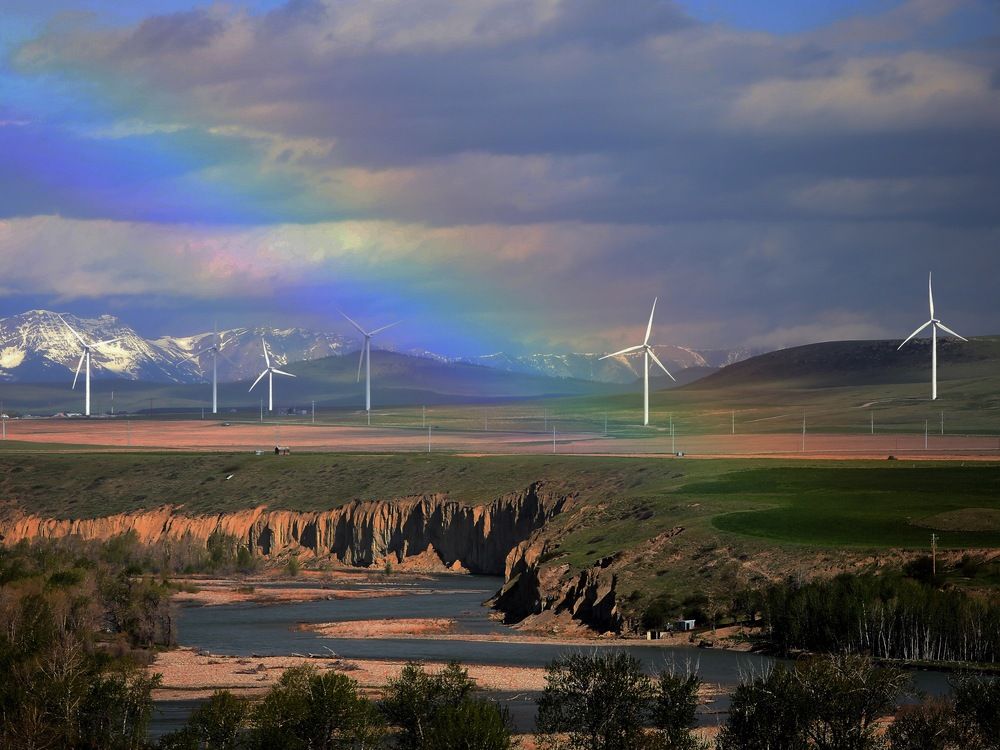Shopify uses electricity to offset all emissions from its employees’ home offices
Content of the article
Two of Canada’s largest companies are teaming up with one of the world’s wealthiest investors to advance renewable energy in Alberta.
Advertisement 2
Content of the article
Shopify Inc. and Royal Bank of Canada, the nation’s largest tech company and lender, respectively, said this week they had signed a “purchasing power agreement,” or PPA, that commits them to buying 90,000 KWh of electricity per year from the Rattlesnake Ridge Wind Power Project, located southwest of Medicine Hat.
The wind farm, owned by billionaire Warren Buffett Berkshire Hathaway Energy Inc., is currently under construction and is expected to be commissioned in May. Toronto-based Bullfrog Power Inc., a renewable energy company, has partnered with Shopify and RBC as part of the deal.
The APP, among the first of its kind, is part of a larger trend among Canadian companies.
Not all companies are willing or able to completely decarbonize their operations, so they instead choose to offset their emissions, either by buying carbon credits or electricity. By putting money on the table, wealthy companies like Shopify and RBC are indirectly buying into renewable energy projects by showing investors that the demand is real, thereby reducing construction risk.
Advertisement 3
Content of the article
“These power purchase agreements are an example of Canadian businesses’ demand for clean, renewable energy to create a more sustainable future,” said Ed Rihn, Senior Vice President, Government Relations and Business Development at the Canadian unit of Berkshire Hathaway Energy. Press release.
Ottawa-based Shopify’s PPA reduction is equivalent to 30,000 KWh per year. Typically, in a PPA, one party purchases electricity from another for its own use. Shopify, however, will not use electricity. Instead, Electric will simply offset all emissions from its employees’ home offices “by adding an equivalent amount of green electricity to the energy grid,” Shopify communications manager Jackie Warren wrote in an e-mail. mail.
Advertisement 4
Content of the article
Warren declined to disclose the precise dollar value of the deal, and when exactly Shopify signed the deal.
Shopify CEO and Founder Tobias Lütke has long been an advocate for sustainable business practices. “I want Shopify to be a company that sees the next century,” he wrote in documents as the company prepared to go public in 2015.

Lütke is an advocate of “direct airborne carbon sequestration”, the capture and storage of carbon. Through Shopify’s sustainability fund, the company buys $1 million worth of sequestered carbon every year. The company also prioritizes carbon neutral operations.
Historically, Shopify has accomplished this through carbon offsets. “In 2020, we purchased carbon offsets to cover our entire historical operational carbon footprint,” Warren said.
Advertisement 5
Content of the article
Carbon offsetting is an indirect way for companies to reduce their environmental footprint. It’s about buying carbon credits and investing the money in projects that will eventually reduce or remove carbon from the atmosphere. The objective of carbon offsetting is therefore not necessarily to make the company’s operations carbon negative, but rather carbon neutral.
“We are proud to continue to lead by example,” said Alex Boulos, vice-president, climate strategy and governance at Royal Bank, in a press release which boasted that RBC was the first Canadian bank to “execute”. two renewable energy PPAs.
Some claim that because greenhouse gases globally mix in the atmosphere, it doesn’t matter where exactly they are reduced. The net reduction is the same no matter where it occurs.
Advertising 6
Content of the article
But it’s an approach that Lütke criticized. “Carbon offsets are often opaque and misleading,” he wrote in a 2019 press release. “Also, carbon offsets don’t often reduce carbon in the air. At best, they slow emissions. At worst, they fund inefficient projects.
-
![Any]()
‘Work from home’ defined the pandemic, but the future is ‘work from anywhere’
-
![Any]()
Ontario at Risk of Losing its Automotive Crown as Cheap, Green Power Gives Quebec the EV Advantage
-
![TransAlta offices shown in downtown Calgary.]()
Turbine collapse prompts TransAlta to rebuild Canadian wind farm
-
![The logo of Royal Dutch Shell is pictured during a launch event for a hydrogen electrolysis plant at Shell's Rhineland refinery in Wesseling near Cologne, Germany.]()
Energy companies compete to recruit talent for a greener future
Shopify has since set its sights on PPAs, which the company says are the “gold standard” for any business that wants to help with the green transition.
“Shopify is proud to be the first Canadian-founded company to sign a power purchase agreement (PPA) to power 100% of employee home offices in North America with wind power,” said the company in a press release.
Stacy Kauk, sustainability manager at Shopify, predicted that PPAs would become an important tool in the fight against climate change.
By purchasing electricity as a group of buyers, Shopify, RBC and Bullfrog Power hope to “stack demand,” swaying the market in favor of clean energy, Kauk said in an email. “One company showing demand is not enough,” Kauk wrote. “Other buyers should do the same.”
• Email: [email protected] | Twitter: marisacoulton






